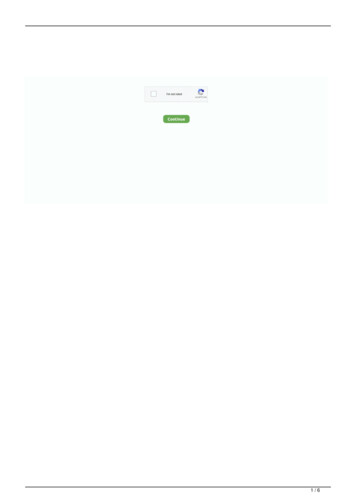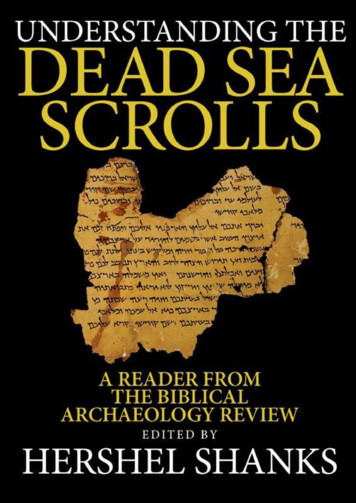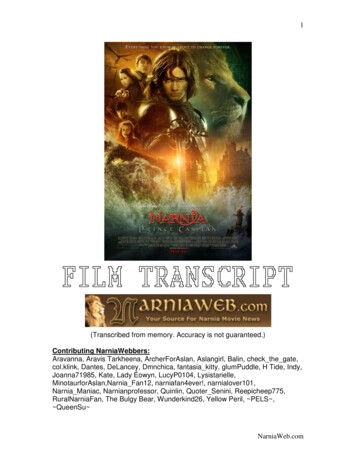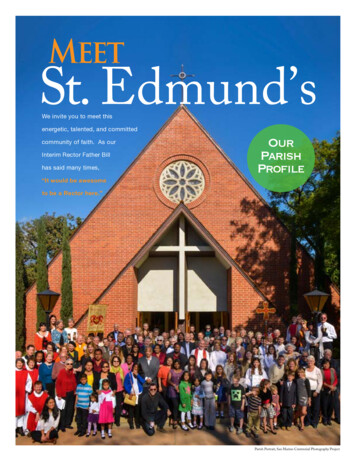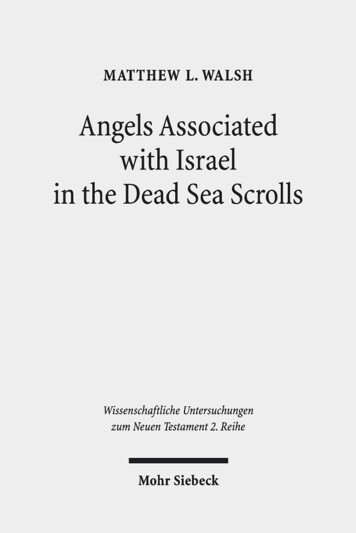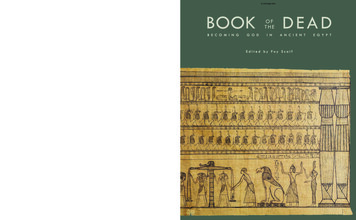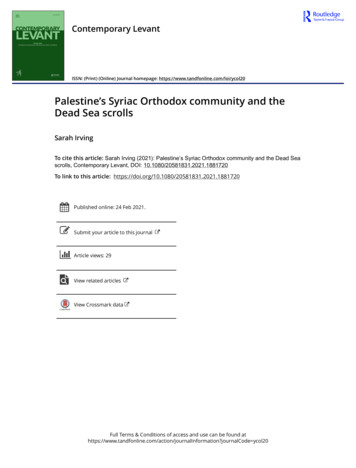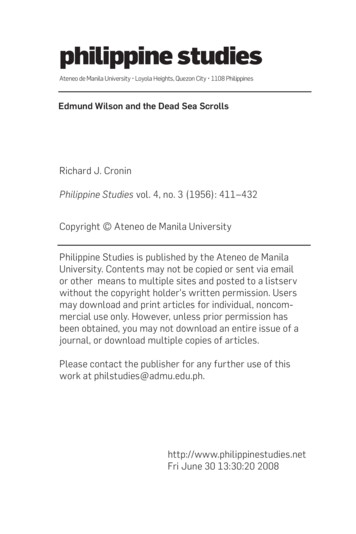
Transcription
philippine studiesAteneo de Manila University Loyola Heights, Quezon City 1108 PhilippinesEdmund Wilson and the Dead Sea ScrollsRichard J. CroninPhilippine Studies vol. 4, no. 3 (1956): 411–432Copyright Ateneo de Manila UniversityPhilippine Studies is published by the Ateneo de ManilaUniversity. Contents may not be copied or sent via emailor other means to multiple sites and posted to a listservwithout the copyright holder’s written permission. Usersmay download and print articles for individual, noncommercial use only. However, unless prior permission hasbeen obtained, you may not download an entire issue of ajournal, or download multiple copies of articles.Please contact the publisher for any further use of thiswork at es.netFri June 30 13:30:20 2008
Edmund Wilson andThe Dead Sea ScrollsRICHARD J. CRONINTHE ancient manuscripts discovered near the Dead Sea jnce1947 and known today as the "Dead Sea Scrolls"have become the talk not only of biblical scholars but ofthe ordinary well-informed reader as well. This fact isattested to by the number and the popularity of books recentlypublished on the subject. There is, for instance, the excellentand absorbingly-readable book by Professor Millar Burrows,formerly of the American School of Oriental Research in Palestine and a t present connected with Yale University. His book isentitled The Dead Sea Scrolls and has gone through severalreprintings.' Another is by the world-famous biblical and archaeological scholar of Johns Hopkins University, Professor William Albright, who was one of the first to give an authoritativeopinion regarding the date of the manuscripts. His book isentitled Recent Discoveries in Bible land . These two works are by noted scholars in the field. Butthe subject of the Dead Sea Scrolls has entered the field ofi,he "best-sellers" in a work written not by a biblical scholaror archaeologist but by a well-known literary critic and bookreviewer for the magazine The New Yorker, Mr. EdmundWilson. His book is ent.itled The Scrolls of the Dead Sea."1 Millar Burrows The Dead Sea Scrolls (New York, The VikingPress, 1955). Cited hereafter a s Burrows.2 William F. Albright Recent Discoveries in Bible Lands(NewYork, Funk and Wagnalls, 1955). Cited hereafter a s Albright.3 Edmund Wilson The Scrolls of the Dead Sea (New York, OxfordUniversity Press 1955). Cited hereafter a s Wilson.
L412PHILIPPINE STUDIESThis book is not only a best-seller: it has been one of the bestselling best-sellers since its publication last October. And nowonder, for Mr. Wilson is an accomplished writer who tellsthe story of the greatest manuscript find of modern timeswith the ease of a skilled reporter. Indeed i t was as a reporterthat Mr. Wilson wrote this book. It is an expanded form ofhis article in The New Yorker for 14 May 1955 entitled "AReporter a t Large: The Scrolls from the Dead Sea.""At some point rather early in the Spring of 1947, aBedouin boy called Muhammed the Wolf was minding somegoats near a cliff on the Western shore of the Dead Sea.Climbing up after one that had strayed, he noticed a cave thathe had not seen before, and he idly threw a stone into it.There was an unfamiliar sound of breqkage. . ." Thus effortlessly begins Edmund Wilson's book (though a much morecritical account, with greater attention to accuracy of detail,is given by Millar Burrows). Unfortunately, although Mr. Wilson gives us a highly readable account of undebatable factsabout the scrolls, he also gives us a very debatable interpretation of those facts. The Dead Sea Scrolls (Mr. Wilson wouldhave us believe) would so explain the origin of Christianity asto explain away its claim to be a divinely revealed religion.Mr. Wilson's interpretation (and indeed much of his information) is not entirely original. Though its expression ishighly personal, it is based on the work of a French scholar, anex-priest, M. Dupont-Sommer, Professor of Semitic Languagesand Civilizations a t the Sorbonne. One of Dupont-Sommer'sworks was translated into English in 19524 and another in1955.5Nor are Mr. Edmund Wilson and Professor Dupont-Sommer the only ones to advocate their interpretation of the DeadSea Scrolls. In January 1956, in three radio talks over the4 A. Dupont-Sommer The Dead Sea Scrolls: a Preliminary Surveytranslated from the French by E. Margaret Rowley (Oxford, BasilBlackwell, 1952). Cited hereafter as Sommer-Rowley.5 A. Dupont-Sommer The Jewish Sect of Qumran m d the Essenestranslated from the French by R. D. Barnett (New York, Macmiilan,1955). Cited hereafter as Sommer-Barnett.
DEAD SEA SCROLLS413British Broadcasting Company, Professor John Allegro, Lecturer in Semitic Philology a t the University of Manchester,advanced an interpretation of the scrolls very similar to thatof Professor Dupont-Sommer and Mr. Edmund Wilson.U7e believe that the interpretations of these three menare not borne out by the evidence. Since the informationnece.wry to correct their viewpoint is not readily available t othe average reader, we shall try in this article to outline theiropinions and to show where these are inadequate. To do thisproperly, we should give a summary of the essential informationregarding the Dead Sea Scrolls.Our discussion might conveniently follow this outline:I. The First Discovery. 11. Later Discoveries. 111. The Dateof These Scrolls. IV. By Whom Were These Scrolls Written?V. Mr. Wilson's Interpretation. VI. Professor Dupont-Sommer's Interpretation. VII. Professor Allegro's Interpretation.I.THE FIRST DISCOVERYIn February or March of 1947, a young Bedouin boy dthe Taamirah tribe named Muhammed "the Wolf" discoveredeleven leather scrolls wrapped in linen in a cave near theNorth-West corner of the Dead Sea.6 The Scrolls had beenstored in clay jars, most of which were by now broken. Thecave was hollowed out of the face of a steep cliff a little overa mile from the shore of the Dead Sea and rising a thousandfeet above the level of the water. About a half mile to theSouth was the ancient site of Khirbet Qumran near WadyQumran (Khirbet and Wady being respectively the Arabicwords for ruin and valley). Even though the scrolls werebadly decomposed a t the ends, Bedouin merchcants decideddue to the strange writing still visible on sections of them tosell them in Jerusalem.Tn July of 1947, through two Syrian Orthodox merchantswho were in contact with the Bedouins, the LVetroplitanSamuel of the Syrian Orthodox Monastery of St. Mark was6 The account of this first discovery will be found in Burrows 1-28and Sommer-Barnett 1-13.
414PHILIPPINE STUDIESable to purchase five of the scrolls. These scrolls included:1) a large scroll, twenty-four feet long, of the entire Book ofIsaiah; 2) two scrolls, together about six feet long, whichmade up a single composition subsequently named The Manualof Discipline; 3) a five-foot scroll containing a commentary onthe first two chapters of Habakkuk; 4) and a scroll in Aramaicwhich turned out to be a commentary on Genesis interwovenwith legends of the Patriarchs, although it was originally considered the lost book of Lamech.In November of 1947, the late Dr. E. L. Sukenik, thenProfessor of Archaeology a t the Hebrew University, bought sixother scrolls of the original find, together with two clay jarsin which the Bedouins claimed to have found the manuscripts.These scrolls when finally unrolled proved to be parts of threedifferent compositions. 1) There was a scroll containing sections of the Book of Isaiah. It had broken up into one largeand several smaller pieces. The larger piece contained fromChapter 38 to the end of Isaiah; the smaller pieces containedexcerpts from Chapters 10, 19-30, and 35-40. 2) A secondscroll, about nine feet long, contained the whole of a composition which scholars entitled The War of the Sans of Light withthe Sons of Darkn.ess, or, as it is more briefly referred to, the"War Scroll." 3) Finally four scrolls were purchased thatcontained twenty psalms of thanksgiving and praise. Althoughother smaller fragments were eventually acquired by the Metropolitan Samuel and Professor Sukenik from the Bedouins, theseeleven scrolls made up the bulk of the first find.With the exception of the St. Mark's Monastery manuscript and the Hebrew University manuscript of Isaiah, the remainder of the scrolls were non-biblical works. Habakkukwas one of the twelve minor prophets, but aside from the linesquoted from Habakkuk, the scroll which the MetropolitanSamuel purchased was mainly a "commentary" by some unknown author who applied the prophecies of Habqkkuk to hisown time. This scroll, as will be seen, is central to the interpret tionof Mr. Wilson. This Commentary, together with the"War Scroll", The Manual of Discipline, and the Thanksgiving Psalms were all religious in nature and were apparently
DEAD SEA SCROLLS415copied out by some religidus sect, who if they did not composethese works, sufficiently esteemed them to preserve them. TheWar of the Sons of Light with t h Sons of Darkness containsinstructions for a war between the tribes of Levi, Judah andBenjamin (the Sons of Light) and the Edomites, Moabites,Ammonites and Greeks (the Sons of Darkness). It is notclear whether these instructions were for a real war or aneschatological war, i.e. a war figuratively described in contemporaneous terms hut predicted to take place a t the end oftime. The hhnual of Discipline is a compilation of liturgicaldirections and rules of admission and government for the religious sect, while the Thanksgiving Psalms are a mosaic ofbiblical reminiscences.11. LATER DISCOVERIESOnce the initial disccvery of scrolls in Qumran I was publicized, scholars were anxious to attempt further discoveries.The outbreak of hostilities in Palestine, however, delayed anyfurther work until early in 1949. Once exploration was againpossible, fresh discoveries followed in rapid succession. Thesediscoveries can be considered under two groupings: 1) theexcavations which identified Qumran I and linked it with thenearby Khirbet Qumran, and 2) the discovery of additionplmanuscripts and manuscript fragments in other caves of thevicinity.On 28 January 1949 Colonel Ashton, archaeological sdviserto the Arab Legion, and Captain Akkash-el-Zebn, a memberof the Legion, investigated what was reported to be the original cave Qumran I. Unfortunately, the cave had recently beenransacked by marauders so that an excavation by trainedarchaeologists was required to guarantee the identity of thecave. Father Roland de Vaux, 0. P. of the Ecole Biblique andMr. G. L. Harding, Inspector of Antiquities for the JordanGovernment, undertook such an expedition in the beginningof February 1949.l After three weeks' work, from the manus7Burrows 33-36; Sommer-Rowley 14-17; 0. R. Sellers "Excavation of the 'Manuscript' Cave a t Ain Fashkha" Bulletin of the AmericanSchools of Oriental Research No. 114 (April 1949) 5-9.
416PHZLZPPZNE STUDIEScript fragments, the potsherds and the linen wrappings thatthey had collected, Father de Vaux and Mr. Harding felt certain that the cave was Qumran I. An additional 600 manuscript fragments were found in the course of this investigation.From the many different compositions of which these fragments had once been part, together with the number of jarsestimated to be in the cave, Qumran I must have contained a tone time over 200 scr011s. With Qumran I identified, Father de Vaux and Mr. Harding made some preliminary soundings a t the nearby KhirbetQumran. It was originally believed to be the ruin of an oldRoman fort from the Third or Fourth Century A.D. and tohave no connection with the nearby cave. The preliminarysoundings discovered nothing to change this opinion althougha large cemetery of over a thousand graves was found between;he fort and the shore of the Dead Sea. From November 24to December 12, 1951, however, Father dc Vaux and Mr. Harding made a more thorough excavation of the ruin and uncovered a building about 118 feet long and 94 feet wide, besides several auxiliary building . From the coins and potteryfound a t this level of excavation, it seemed certain that thebuilding had been occupied in the First Century A.D. Theseries of coins discovered dated from the Procurators of theEmperor Augustus (6 A.D.) until the F'irst Jewish Revolt(66-70 A.D.) .A later expedition of Father de Vaux and Mr. Hardingfrom February 9 to April 24, 1953 revealed a still earlier levelof occupation which had ended with an earthquake which occurred approximately in 30 . c . l @ C o i na ts this earlier lwelwent as far back as the period of John Hyrcanus (135-104B.c.). In one large room of this building were found longtables (suitable as desks) and copper inkwells, some of whichstill contained ink in a dried-up condition. From these excavaSommer-Rowley 17.Burrows 54-56; Sommer-Barnett 167-171; Roland de Vaux, O.P."Fouilles au Khirbet Qumran" Reveu biblique 61 (janvier 1954) 83-106.1 0 Burrows 64-65 ; Sommer-Barnett 167-171; R.de Vaux, O.P."Fouilles au Khirbet Qumran" Revue biblique 61 (avril 1954) 206-236.
DEAD SEA SCROLLS417tions it was evident that the ruin was not a Roman fort. Thebuilding must have been occupied both a t the time when thescrolls were written and later when they were stored in Qumran I. It must have housed a large community, and the largeroom with desks and inkwells must have served as scriptorium.The large size of the cemetery also indicated that other membersof the community may have lived in the nearby caves, comingto the central building for community functions.Aside from the excavations a t Qumran I and KhirbetQumran, further valuable manuscript discoveries were provided by a thorough investigation of other caves in the WadyQumran area. From March 10 to March 29, 1952 Father deVaux and Professor William L. Reed of Texas ChristianUniversity led the Qumran Cave Expedition which investigatedthe caves within a five-mile radius of Qumran I." Almostforty other caves which had been used for storage were discovered. In two of these caves were found manuscript fragments. In one of them were discovered two copper scrolls.When unrolled, their length was estimated to be about eightfeet. Apparently from the holes a t the end of each of thesescrolls they had once been riveted together, or, as Father deVaux conjectured, nailed to the wall of the central building.The scrolls were so oxidized by the time they were found thatunrolling them presented a difficult problem. Also, one scroll wasmade up of two sheets that had practically melted together.They finally had to be cut apart by a special metal saw. Thisprocess has only recently been ompleted.' Their contentshave not as yet been published, but the very material on whichthey were written indicates their composers must have placeda special value on their contents.On 22 September 1952, a further expedition to this sameWady Qumran area discovered a chamber which containedthousands of manuscript fragments.13 This chamber was'1 Burrows 59-61 ; Sommer-Barnett 171-174; R. de Vaux "Exploration de la region de Qumran" Revue biblique 60 (octobre 1953) 540-561.l 2Manchoster Guardian Weekly 74 ( 8 March 1956) 14.IS Burrows 62-63 ; Sommer-Barnett 173.
PHILIPPINE STUDIES418named Qumran IV. At least 60 different compositions havealready been recognized from among the fragments discoveredin this chamber, and 330 different manuscripts have beenidentified, 90 of them biblical. The value of Qumran IV mayeven surpass the original finds in Qumran I. Besides thesediscoveries in the W-ady Qumran area, numerous manuscriptsand manuscript fragments, mostly from the early centuriesA.D., have been located in the caves of Wady Murabbaat, 11miles South of Qumran I,I4 and in Wady en-Nar, 9 milesSouth-East of Jerusalem in a continuation of the Kedron ValSince the original discovery of 1947, many completemanuscripts and tens of thousands of manuscript fragmentshave been found. These fragments vary in size from piecescontaining several columns to others containing only a fewletters. At present these discoveries are housed in the PalestineArchaeological Museum where under the direction of Fatherde Vaux a small group of scholars is patiently cleaning, sortingand identifying them. The correlation and publication of allthese fragments will a t the very least take ten years.16111.THE DATE OF THE SCROLLSOnce the Qumran Scrolls were discovered, scholars werefaced with the problem of dating their finds. When were thesescrolls of Qumran I written? The correct answer to that question would of course be a great help in answering the stillmore important question: how should these scrolls be interpreted? Fortunately, in recent years the methods of datingby archaeology, by the radio carbon-14 process, and by paleography have been greatly refined. All these methods havebeen brought to bear on the problem of dating the scrolls ofQumran I. Since the method of dating from the historicalallusions in the texts of the scrolls presents special difficulties,it will be considered separately.14 Burrows 57-59; Sommer-Barnett 8-13, 174-177; R. de Vaux "LesGrottes de Murabbaat et leurs documents" Revue biblique 60 (avril1953) 245-267.1 5 Burrows 61 ; Sommer-Barnett 178-179.16 Wilson 108-110.
DEAD SEA SCROLLS419Although archaeology cannot answer precisely when thescrolls were written, it can tell us when the scrolls were deposited in Qumran I. This automatically determines thelatest possible date for the composition of the scrolls. Inthe excavation of Father de Vaux and Mr. Harding a t KhirbetQumran in 1951 a jar was discovered which was identicalin type with the jars used to store the manuscripts in QumranI. From the coins found with it, this jar of Khirbet Qumran-and consequently the identical type of jar in the cave-could be dated between 6 A.D. and 70 A.D. Since the scrollswere probably stored in Qumran I when the building wasdeserted (the linen wrappings coated with pitch indicate theywere not placed there for immediate use), the date when themanuscripts were placed in the cave would be close to 70 A.D.17The linen wrappings in which the scrolls were found offered another confirmatory indication of the antiquity of thescroIls, although not as precise as the archaeological methodjust mentioned. Two different methods of dating were applied to these wrappings. First, sections of the linen weresent to the H.M. Norfolk Flax Establishment in England andto the Textile Museum in Washington. From a microscopeexamination of the weave, both of these independent investigations confirmed that the linen was an ancient Palestinian product, without however trying to establish any more precise date.Secondly, in 1950 another section of the linen was sentto W. F. Libby of the Institute of Nuclear Physics of theUniversity of Chicago to be tested by the radio carbon-14process. By measuring the amount of radioactive carbon present in the linen, this process can estimate its age within amargin of error of 200 years. Dr. Libby determined thatt,he linen waq 1917 years old, which (taking into accountthe margin of error) placed its manufacture somewhere between167 R.C. and 233 A . D . ' Cf. supra notes 9 and 10; also Burrows 73-83.18 Burrows 82; Willard F. Libby Radw Carbon Dating (Chicago1952) p. 72.17
420PHILIPPINE STUDIESTo determine when the scrolls were actually written,scholars turn to paleography, the science which studies thegradual modification of the script in which the manuscriptsare written. By itself paleography cannot determine the dateof a particular script. I t can only say that one type of scriptis older or more recent than another. Yet, comparing thescript of a manuscript of unknown date with that of a manuscript of known date, the date of the unknown manuscriptcan be estimated. Professor S. A. Birnbaum of the Universityof Iandon has in this manner dated the St. Mark's MonasteryIsaiah Scroll (the oldest of the Qumran 1 scrolls) between175 and 150 . c . * r o f e s s Albrightorof Johns HopkinsUniversity has judged the script of the "War Scroll" (the mostrecent of the scrolls) to belong to the first decades of theFirst Century A.D. OThe most disputed method of dating the Qumran Scrollshas been the attempt to identify the historical allusions in thetexts of the scrolls with actual events or persons of Jewishhistory. Since the Habakkuk Commentary is rich in suchallusions and plays an important part in Mr. Wilson's interpretation of the scrolls, it can serve to illustrate the difficultyof identifying historical events from the allusions made in thisscroll. What is said here of the caution that is required fordating can equally apply to historical parallels drawn betweenthe Habakkuk Commentary and the origins of Christianity.The method of dating a manuscript from historical allusions depends on the clarity of the allusions made in themanuscript. In the Habakkuk Commentary the allusions inthe text are not clear, and the period of Jewish history towhich the Commentary refers is not as thoroughly known ashistorians would wish.But eves if the allusions in the Habakkuk Commentarywere clearer, the very number of them would present difficulty.19 Burrows 36, 89; Solomon A. Birnbaum "The Dates of the CaveScrolls" Bulletin of the American Schools of Oriental Resewoh No. 115(October 1949) 20-22.20 Albright 130.
DEAD SEA SCROLLS421Among his contemporaries to whom the writer of the scrollrefers are: 1) the Kittim, the foreign enemies of the Qumransect; 2) the Teacher of Righteousness, a priest of the sectwith the power of interpreting the prophets; 3) The Houseof Ahsolom, opponents of the Teacher of Righteousness; 4)the Wicked Priest and the Preacher of the Lie, other enemiesof the Teacher of Righteousness. These titles are so genericit is practically impossible to link them with certainty to aspecific figure of Jewish history. Nor are single identifications enough. The period in which such an identification isattempted must also provide contemporaries to fit the otherallusions as well. Since the Pre-Maccabean (332-168 B.c.),the Maccabean (168-63 B.c.), and the Roman (68 B.C. upto and beyond 70 A.D.) are all possible periods in which thepeople referred to by the commentator may have lived, MillarBurrows notes that no identification of the historical allusionsIn the Habakkuk Commentary is completely con incing. IV. BY WHOM WERE T H E SCROLLS WRITTENWho precisely were the men who lived in Khirbet Qumran and copied out the Dead Sea Scrolls? Three historians ofthe First Century A.D.-Pliny the Elder, Josephus, and Philohave given a clue to the solutioll of this question in their description of the Essene sect. The many close similarities betweentheir account of the Essenes and the description of the Qumran community in the scrolls have convinced most scholars thatthese two groups were essentially the same.In his Natural History, the Roman historian Pliny givesthis short description of the Essenes:On t.he west side of the Dead Sea, but out of range of the noxiousexhalations of the coast, is the solitary tribe of the Esmes, which isremarkable beyond all the other tribes in the whole world, as it hasno women and has renounced all sexual desire, has no money, and hasonly palm-trees for company . . . .z z21Burrows 185.22 Natural History V. xv. 73 (Pliny, vol. 2, in the Loeb ClassicalLibrary).
PHILIPPINE STUDIES422Roman superiority reasserts itself when Pliny adds that theEssenes recruited their members from "men who, weary of life,have been driven by the vicissitudes of life to adopt their manner of living."Philo, an Alexandrian Jew, gives a more sympathetic description of the Essenes in his Every Good Man is Free.23 TheEssenes' chief concern is the pursuit of virtue. To attain this,they refuse to swear oaths and they observe ceremonial purity.Their study is of morals and religion, particularly the allegorical interpretation of Scripture. They hold all goads in common and possess no slaves. In his Hypothetica, Philo furtheradds that the Essenes only admit adults to their sect and refrain from marriage.24In The Jewish War,25Josephus ranks the Essenes amongthe three major Jewish groups of his time. Since he had observed the group a t first hand, and may have even lived withthem for a while,26his account is of some value. The Esseneslive in various cities and are noted for the brotherly hospitality that they display to visiting members of the sect. Theyhave a piety peculiar to themselves which lays great stress oncharity to the poor, on silence, and on moderation in speech.The group has a definite hierarchy of rank. Only after completing the two probationary periods and swearing the initiatory oath, is the candidate allowed to share in the commonsacred meal. In the A n t i q i t i e s J, w p h u s mentions the priesthood of the sect which received the harvests of the othermembers and prepared the sacred meals. Also according to thisaccount, there were about 4000 Essenes a t the time Josephuswrote.The similarities between this account of the historiansand the description in the Qumran Scrolls, especially TheManual of Discipline, are striking. The major concern of boththe Qumran group and the Essenes was the pursuit of virtue(Philo, vol. 9, Loeb).2 3 Everg Good Man is Free 75-88.(Philo, vol. 9, Loeb) .24 Hypothetica 11.1-8.25The Jewish War 11.119-161. (Josephus, vol. 2, Loeb).i. (Josephus, vol. 1, Loeb) ; F. J. Foakes Jackson Josephus26Lifeand the Jews (New York 1930) pp. 6, 79.27Antiq. xviii.1.
DEAD SEA SCROLLS423through a study of Scripture and the Law. For both, twoprobationary periods and an oath of initiation was requiredbefore the new member could partake of the common sacredmeal. In the Qumran group (as among the Essenes) therewere definite grades of membership; all goods were owned bythe community; and the later members of the sect most probably were celibates. The two groups do differ, however, oncertain points: for example, the prescriptions of sacrifice inthe Temple.Because of this and other differences between the twogroups, Professor Burrows holds the following moderate posit,ion on the identification of the Essenes with the Qumran sect:. .if several related sects are included under the term Essene,the covenanters [i.e., the Qumran group] may be called Essenes;if by Essene we mean a particular sect, which we assume tohe accurately described by the ancient writers, then the covenanter.;were not Essenes. For the present it seems to me best not to speakof the Qumran sect as Essenes, but rather to say that the Essenes andthe covenantars, with other zroups of which we know little or nothing,represented the same general type . . .28.With a review of the salient information completed, Mr.Wilson's interpretation of the Dead Sen Scrolls can now beconsidered. I t should be noted in advance that Mr. Vi7ilsonis not a biblical scholar. He is a literary critic and editor, bestknown perhaps for such books as Axel's Castle and T o theFinland Stntion and for his columns and boolr reviews in TheNeru Yorker.What is Mr. Wilson's interpretation of the Dead SeaScrolls? Two passages from the fifth chapter of his boolr("What would Renan have said?") sum up the essence of hisposition. They are both carefully, almost subtly, worded. Yet,although the words seem hesitant acd diffident, the tone clearly reveals Mr. Wilson's own conviction. The first passage ismade up of two rhetorical questions:28Burrows 294.
PHILIPPINE ST UDIES.Or will the explanation of Jesus-ss well as of Paul-in termsof preexistent factors, the placing him and visualizing him in a definitehistorical setting, inevitably have the effect of weakening the claimsof divinity that have been made for him by the Church?.Willor will not this process of elucidation inevitably have the effect ofmaking Jesus seem less superhuman till he has come to appear miraculous only in the sense, say, that Shakespeare is miraculous: in relaYes: only the believer can answertion to his predecessors?.29this . .A few pages later Mr. Wilson introduces this same thought ina slightly different form. . and i t would seem an immense advantage for cultural and socialintercourse--that is, for civilization-thatthe rise of Christianityehould, a t last, be generally understood as simply a n episode of humanhistory rather than propagated as dogma and divine revelation. Thestudy of the Dead Sea Scrolls-with the direction i t is now takingcannot fail, one would think, to conduce to this.30Reviewing Wilson's The Scrolls from the Dead Sea forthe New York Times, Dr. Frank Cross, Professor of Old Testament a t McCormick Theological Seminary, clearly pointedout the flaw in Mr. Wilson's interpretation:W t a tMr. Wilson is btruggling to say, presumably, is that hewish that people would give up theological interpretations of humanhistory; that on reading the scrolls, the Christian will properly giveup his faith once he understands that the primitive Christian community had direct connections with its Jewish past, and that its worldview, institutions and so on, are derived from or a4 least have continuity with the historical milieu of the first century A.D. in Palestine.The presumption is that Christian doctrine regarda revelation as thesuspension of the normal historical process.The author is merely expressing a confusion common to the era ofthe fundamentalist-modernist fights of a generation ago, And i t is truethat Christians (or mutatis mutandis Jews) who share his confusionwill be badly shaken up as the implications of the scrolls are spelledout. On the other hand, thcse acquainted with contemporary theologyo r with critical biblical scholarship, are wel! aware that the eventsconceived in Christian (or Jewish) dogma as "acts of God" are continuous with, and indistinguishable from other events of history so longa s they are viewed by the historian as historian. Indeed, the Chris2930Wilson 102-104.Wilson 108.
DEAD SEA SCROLLS425tian doctri
The Dead Sea Scrolls RICHARD J. CRONIN T HE ancient manuscripts discovered near the Dead Sea jnce 1947 and known today as the "Dead Sea Scrolls" have become the talk not only of biblical scholars but of the ordinary well-informed reader as well. This fact is attested to by the number and the popularity of books recently


